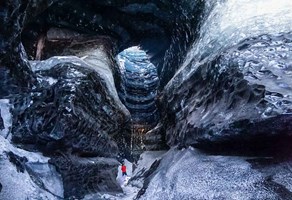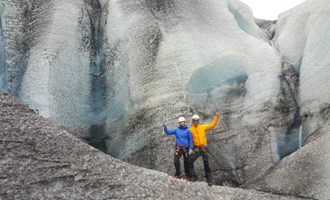ABOUT GLACIERS IN ICELAND
Iceland's glaciers cover about 11.1% of the country's area. These large masses of ice slide down the slope in the shape of a tongue and have a great capacity for movement. Many of the glaciers in Iceland have formed on still active volcanoes, which makes them have special characteristics. When these volcanoes erupt, the ice on the glacier that covers them melts very quickly and a phenomenon occurs that Icelanders call “jökulhlaup”, which means a sudden and devastating flood.
The future of glaciers is in danger because of greenhouse gases that makes glaciers gradually disappear, recent studies confirm that glacier cover in Iceland down 18% in 130 years.
HOW ARE GLACIERS FORMED?
A glacier is a compressed mass of ice that forms when falling snow accumulates year after year in layers. These layers are compressed by their own weight and the action of gravity in a process of hundreds and thousands of years. Glaciers have the capacity to move and flow slowly like rivers and find their way between mountains. They are a great source of fresh water for our planet, along with rivers and lakes.
HOW CAN I SEE A GLACIER IN ICELAND?
The safest way to visit Iceland's glaciers and be able to step on the ice is through snowmobile tours, ice caves, or glacier walks, with specialized companies. With these tours you can enjoy a real and safe experience on the glacier. Glaciers should never be visited on your own, without the proper equipment or without a specialized glacier guide, it could become a dangerous experience, let's never forget that nature can be unpredictable. To enjoy this experience, visit our snowmobile tours, ice cave tours, or glacier walks tours.
ABOUT SÓLHEIMAJÖKULL GLACIER
Sólheimajökull is one of the most visited glaciers in Iceland. It is a glacial tongue that comes from the main glacier Mýrdalsjökull. This glacier has some peculiarities, for example black ash. A part of the glacier is covered with the mixture of deposited material washed away by the rains and the ash from the eruption of the nearby Eyjafjallajökull volcano in 2010, giving the glacier a very characteristic appearance in some areas. You can also find crevasses across the surface, dirt cones, ice ridges, blue ice, and occasionally if you are lucky, you can find ice caves.
Sólheimajökull has a glacier lagoon at its base, sadly, due to the rapid melting of the glacier caused by climate change.
Located 160 Km from Reykjavík, is an easy access by driving: from the main road 1, you need to take road 221 (suitable for all vehicles), and then you reach a parking lot. From here there are 2 options: walk along a marked path (approx. 20-25 minutes) and see the glacier from the viewpoint, or access the ice with a guided tour. Visit our glacier walk tours.
ABOUT SKAFTAFELL
Skaftafell belongs to the Vatnajökull National Park, it is a protected area of the Park. In the National Park is the Vatnajökull glacier, the largest and most voluminous ice cap in Iceland. The maximum thickness of the ice is 1,000 meters with an average thickness of 400 meters. There is located the highest peak of Iceland, Hvannadalshjúkur, about 2,109 meters.
From the main glacier Vatnajökull, numerous outlet glaciers flow, which can be seen from the road while driving providing you spectacular views. The glacier hike tours that are done in the area depart from Skaftafell, and are carried out in these glacier outlets, which can be one or the other depending on the changing conditions of the glaciers, safety, etc. Although in recent times the one that has been used the most for glacier hikes has been Falljökull. Visit our glacier hike tours.
Other well-known glaciers in the area are Öræfajökull, Skaftafellsjökull and Svínafellsjökull.
Skaftafell is located in the South East of Iceland, about 4 hour driving from Reykjavík. And it is easily accessible from Road 1 by following the signs for Skaftafell and arriving at the Visitor Center.



















